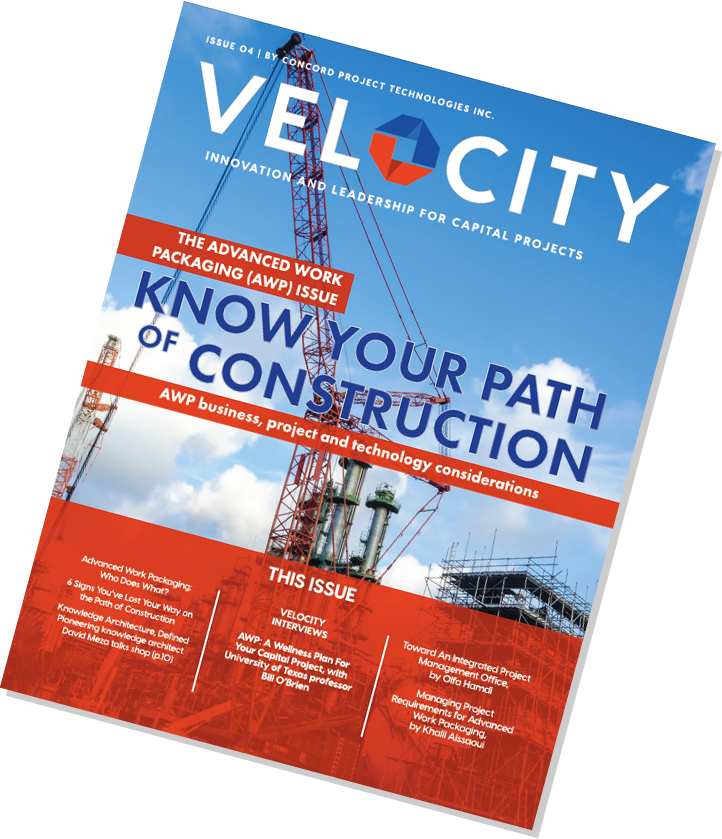A step-by-step guide to roles and responsibilities for companies and teams new to the Advanced Work Packaging methodology
“How will my job change if my company adopts Advanced Work Packaging (AWP)?”
In nearly a decade at the forefront of AWP research and training, this is the question I hear most often from people working on the front lines in capital construction.
Change can be challenging, even for the most progressive and ambitious thinkers in your company. Some of these people will see changing organizational structures as an opportunity, but just as many — perhaps many more — will greet AWP with worry and resistance.
So the first step is to consider where you’re starting from. Only then can you establish a baseline for understanding how AWP will impact your organization — and the jobs of those who work there.
Traditional Roles vs. AWP Roles
A traditional capital construction team will typically have a project manager at the center surrounded by discipline leads, construction and procurement professionals. There will be operations and maintenance teams, assurance teams and a host of supporting functions. These critical core positions make up the backbone of every good, integrated project team.
When adopting AWP, many companies find they already have the skills in-house to staff for AWP roles and put AWP into practice. Others find they need to hire from outside. Regardless of where you fall on the spectrum, these are the three most important AWP-specific roles you’ll want to create as you embark on your first AWP implementation:
1 | The AWP Champion
The person you choose as your AWP champion is at the epicenter of your new work packaging program and the key to its success. She is the central point of contact for AWP implementation: She’ll be the main driver behind all of your integration efforts, and the person responsible for fostering a spirit of collaboration that encourages the entire team to get on board.
Implementing AWP is a process. It will bring changes to long-standing roles, and silos will have to be broken down. Your AWP champion needs to be both a resource for information, a source of practical assistance, and a skilled motivator – a true servant leader. Ultimately, the measure of your champion’s success is how successfully your team implements AWP — a tall order.
This can be a challenging role to fill, and many companies find themselves looking to the project manager, the construction manager or experienced members of the engineering team. Another option is to hire an outside advisor who specializes in the transition to AWP. In the latter case, it is critical you assign someone within your project organization to accompany the AWP champion to learn from them and ensure the transfer of the know-how. AWP needs to be owned and piloted from within.
Regardless of who you choose for this critical role, the person must have real, formal authority across the entire project team and throughout the entire project lifecycle. An AWP champion cannot simply be an “advisor” who makes “recommendations” — people won’t change. The reality is that old habits die hard. You brought in your AWP champion to slay them. Give her a sword.
The most common way to do this is by creating a reporting structure that makes the AWP champion a direct report to the project sponsor — or, at the very least, the project manager. As a direct report, she’ll have default authority.
2 | The WorkFace Planner
The WorkFace Planner is another critical position that is unique to AWP organizations. He sits between the office and the field, and is responsible for planning your work packages.
To do this, the WorkFace Planner receives and organizes all of the materials and information coming in from multiple office teams, including engineering and procurement. He then uses this information to develop comprehensive, actionable work packages that can be efficiently executed in the field. it’s some serious heavy-lifting, and requires a deep understanding and a strong skill set.
When looking to hire a WorkFace Planner, many companies find themselves looking to site planners and engineers with a lots of experience and a good understanding of the construction sequence, along with planning experience and competencies. This is a critical link — you’ll want to make it a strong one.
One of the key benefits of AWP, overall, is that many companies realize for the first time that they don’t have anyone actively coordinating communication between the office and the field. This alone can have a powerful impact on productivity and efficiency across the entire project lifecycle.
3 | The Integration Manager
The Integration Manager role is not defined in CII’s formal practice model for AWP, which was developed in 2013 and which I co-authored. However, in the intervening years, technology has come to play a much a bigger role, and I’ve noticed that the lack interoperability in our industry is preventing AWP from reaching its full potential. In short, it has then become clear that this new and evolving role is critical to making AWP implementation a success.
The fact is that on a multi-billion dollar project, there will be millions of gigabytes of information exchanged between hundreds of people. AWP is about integration, and about establishing and maintaining a single source of truth. If we’re going to achieve that lofty goal, someone has to make it their full-time job.
Known variously as information manager or data manager, we advocate for the Integration Manager role as being the person responsible for the day-to-day flow of information, the integration of data sources to the 3D model as well as consistent documentation of both the engineering and non-engineering information.
Her goal is to ensure not only that the information available to all teams is accurate and up-to-date, but that the right information is being shared at the right time, which is consistent with being a gatekeeper for the information workflows. Like a document manager, the Integration Manager will be responsible for keeping track of thousands of documents exchanged during the course of a project and ensuring their content is consistent with the success requirements of a project. However, she’ll also intervene to facilitate the exchange of information she deems critical, and to open up communication where she deems it necessary.
Ultimately, your Integration Manager is responsible for streamlining the exchange of information and fostering collaboration between departments, beyond the traditional corporate boundaries. It’s a key function that stretches between and among departments, contractors and other key stakeholders. She’ll have the mandate and authority to question everything from established workflows to the organization of unstructured data, and she’ll provide sustained knowledge management across all departments, throughout the project lifecycle.
Establishing these three roles will get you well on your way to implementing Advanced Work Packaging, and benefiting from the tremendous efficiencies the methodology offers. Start today!
Concord® Project Technologies provides technology-powered AWP integration management services using a unique open architecture powerful platform designed for AWP support, AWP workflow and team integration. Thinking of piloting AWP? thinking of taking your AWP implementation to the next level? Contact us to learn more about our value proposition.





